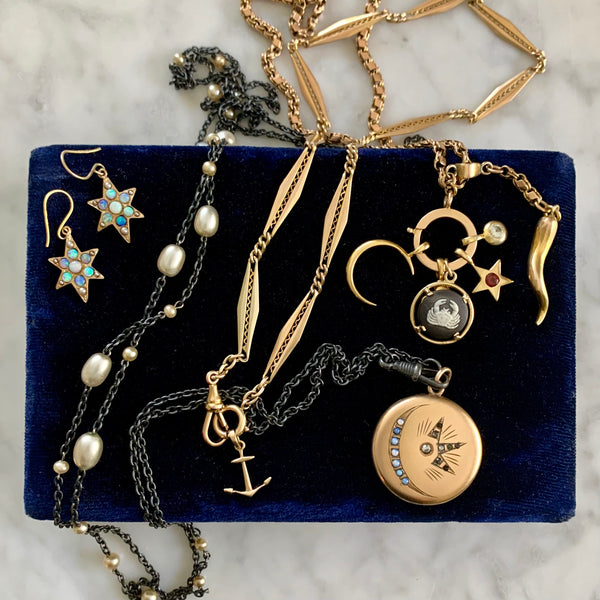Your Cart is Empty
About Birthstones
The idea that twelve gemstones represent the twelve months of the year may find its origin in biblical times and the twelve stones on the breastplate of Aaron, the first high priest. Each stone was believed to carry special mystical powers and over time became associated with the months of the year and the signs of the zodiac. Medieval Europeans, for example, regularly associated a gemstone with an individual’s month of birth. And world cultures including Roman, Spanish, Italian, Russian, Arabic, Jewish, Polish and Ayurvedic in India have generated different birthstone lists. In 1912 the National Jeweler's Association adopted the list that is most common today. Though birthstones are a relatively recent tradition in the United States, each one is imbued with centuries of legend and lore.

|
January: Garnet
During the course of human history, the deep-red garnet has inspired numerous legends and acts of devotion. With discovery dating back at least to the Bronze Age, the semiprecious stone has been found in cultures around the world, in areas as widely scattered as Sweden, Central America and Egypt. Among many other ancient texts, the Old Testament contains frequent references to the garnet as a protective amulet and a source of inspirational illumination. More recently, the garnet was a favorite stone of European royalty, who prized its crimson hue and associations with power and prosperity. Today, January’s birthstone bears the symbolic color of love, and is known as a beautiful emblem of trust, loyalty and endless affection. |
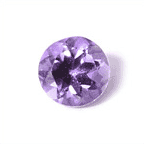
|
February: Amethyst
Few gemstones have inspired so many romantic legends as the amethyst. With its brilliant sparkle and deep violet hue, it was a favorite adornment of kings, warriors and mystics for millennia. According to Greek mythology, the soulful purple crystal was created when the god Dionysus wept tears of wine on a beautiful young woman who had been turned into to a statue of white quartz. While today it retains its associations with love, February’s birthstone is now also symbolic of loyalty, trust and the other coveted qualities of friendship. |
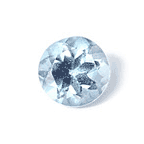
|
March: Aquamarine
Aptly named for its crystal clarity and soft blue hue evoking the sea, March’s birthstone has a storied history. One folk legend states that the beautiful gemstone was first discovered in the treasure chest of mermaids. Accordingly, sailors once carried aquamarine with them out to sea, believing that it would offer protection from the wind and waves. Aquamarine has also long been a favorite of mystics and medics around the world, and is often believed to bring peace, serenity and wisdom to those who wear it. back to top
|
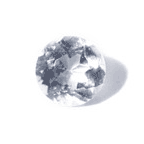
|
April: Diamond
Age-old symbol of love, strength and eternal devotion, the diamond has been coveted and exchanged with loved ones since ancient times. The legendary gemstone’s clarity, beauty and alleged mystical properties have also fueled the human imagination throughout history. It is said that the ancient Greeks believed that diamonds were shards of fallen stars, while in medieval Europe, the stone was used as a talisman to ward off bad luck and protect its wearer. An ancient Asian legend told of an entire hidden valley paved with diamonds. Today, the precious stone is a classic token of love, friendship and unbreakable family bonds, as well as a special tribute to babies born in April. back to top
|
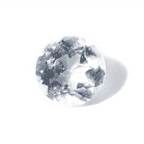 |
White Sapphire
The sapphire is naturally found in a variety of colors and was once considered so sacred as to be considered “the gem of gems.” One ancient legend even stated that the Biblical Ten Commandments were written on tablets of sapphire, rather than stone. In 12th century France, sapphires were worn as emblems of spiritual truth, most commonly in rings. At other times they’ve been carried as protection by travelers, used to promote serenity and sincerity, and as a cure for a variety of ailments. Today, the semiprecious white sapphire is often associated with friendship and loyalty, qualities for which ancient Buddhists also once cherished it. back to top
|
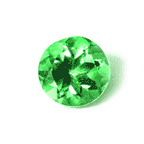
|
May: Emerald
Coveted for more than 5,000 years, the deep green emerald has a rich and romantic history. Ancient Egyptian emerald mines near the Red Sea were known as “Cleopatra’s Mines” after the charismatic queen’s love of gemstones. Indian maharajas are known to have collected emeralds, and modern-day treasure hunters have discovered Spanish galleons brimming with the stones, hoarded by conquistadores of long ago. Said to give its owner eloquence and intelligence, the precious stone is equally prized for its gorgeous hue. The green gem has long symbolized nature, spring and rebirth, making it a fitting birthstone for May babies. back to top
|
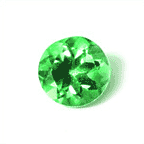 |
Siberian Emerald
Renowned for their crystal clarity and the deep emerald-green hue for which they are named, semiprecious Siberian emeralds evoke the rich Russian forests near which they are found. It is said that the beautiful stone was first discovered in the roots of a storm-felled tree by a Russian peasant in the early 19th century. Yet scholars have discovered mentions of what might be Siberian emeralds dating back to the first century AD, bringing a bit of intriguing mystery to the stone’s origins. Today they are worn as a classic spring-green tribute to those born in May. back to top
|
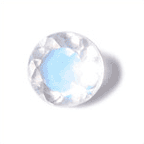
|
June: Moonstone
Appearing to glow from within, the moonstone has an intriguing mythic history. Long ago it was thought that one could see the future by holding a moonstone in one’s mouth. Ancient Romans believed that the stone’s soft internal glow was created from the actual light of the moon. Long associated with good fortune, the moonstone was also once known as the “traveler’s stone” for its alleged ability to protect one from harm when away from home. With its subtle blue hue and shifting light effects, the moonstone is a beautiful tribute to those born in June. back to top
|
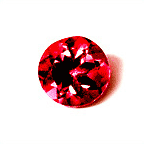
|
July: Ruby
Referred to as “the flower of the sun” by English poet Ben Jonson, and known as “the king of gems” by the ancients, the ruby has long been celebrated for its fiery beauty and romantic associations. The red gem was a favorite adornment of warriors and English royals, to whom it symbolized freedom, charity, dignity and divine strength. It was also once prized for its healing powers in matters of the heart. Today, the July birthstone retains its suggestions of romance and passion for life, and is also said to bring contentment and peace to its wearer. back to top
|
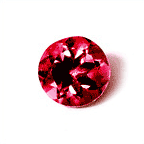 |
Rubellite
Fiery red semiprecious rubellite is one of the most prized members of the tourmaline family. Owing to tourmaline’s wide array of naturally occurring colors, an Egyptian legend stated that the gemstones passed over a rainbow and gathered its colors on their journey out from the center of the earth. Commonly associated with love and friendship, July’s birthstone is a beautiful token of affection. back to top
|
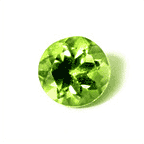
|
August: Peridot
Coveted by the ancient Egyptians, who referred to it as “the gem of the sun,” the brilliant green peridot has been mined for millennia. Pharaohs collected carved peridot talismans, which they thought could ward off ill fortune. During the Middle Ages, Europeans believed in the holy power of the gem and used it to decorate churches and vestments. In more recent times, the beautiful green stone has come to represent friendship and is often considered an aid to affection and camaraderie. With its summery green hue and sparkle, it is a fitting emblem of those born in August. back to top
|
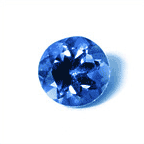
|
September: Blue Sapphire
With a brilliant blue sparkle that evokes both sea and sky, the sapphire has inspired countless myths and legends throughout history. In earlier times, some people believed that the sky was an enormous blue sapphire in which the earth was embedded. Accordingly, medieval clergy wore sapphires to represent heaven. The beautiful blue stone has long been favored for British royal engagement rings, and also adorns the cross of the English imperial crown. Today, September’s birthstone represents truth, sincerity, love, friendship and faithfulness. back to top
|
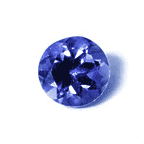 |
Iolite
The deep blue hues of semiprecious iolite evoke the sea and the sailors who have long been fond of it. As far back as the Vikings, the stone was used as a navigation tool – by holding it up to the sun, one could filter the rays and determine one’s location at sea. It is said that Leif Eriksson relied on the guiding powers of iolite during his far-reaching explorations. Also known as “water sapphire,” September’s birthstone is still prized today for its beauty and lingering associations with guidance and illumination. back to top
|
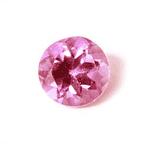
|
October: Pink Tourmaline
Pink tourmaline has long been coveted both for its beauty and alleged healing properties. It also bears age-old associations with inspiration and creativity. The last Empress of China loved the stone so much that she possessed nearly a ton of it, including a carved pink tourmaline pillow. Once thought to be rubies, there are numerous brilliant pink tourmalines among the 17th century Russian crown jewels. Today, the rosy gemstone is still considered a lucky talisman in many parts of the world, in addition to being a beautiful tribute to those born in October. back to top
|
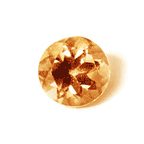
|
November: Citrine
Suggestive of autumn’s golden sunshine and turning leaves, citrine is a beautifully fitting emblem of those born in November. The colorful gemstone was a favorite of the ancient Romans, who used it frequently in jewelry and decorative embellishment. Citrine’s glamorous reputation was bolstered during the Art Deco period, when it was often seen on Hollywood stars, such as Greta Garbo and Joan Crawford. Today, citrine symbolizes joy, and is also thought to promote creativity, wisdom and peace in those who wear it. back to top
|
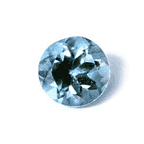
|
December: Blue Topaz
Icy blue topaz has a long and storied history. According to tradition, the gem promotes truthfulness and confers insight to its wearer. In ancient Mexico it was thus employed during conflicts to obtain the truth from opposing parties. It was said that the color of the stone would become darker once the truth was revealed. The Greeks additionally believed that blue topaz increased physical strength and made its wearer invincible, while the Romans thought that it improved eyesight. Today, the stone is celebrated for its beautiful blue hue, which suggests the sea, the sky, and the crystalline qualities of winter that make it a fitting birthstone for December. back to top
|

